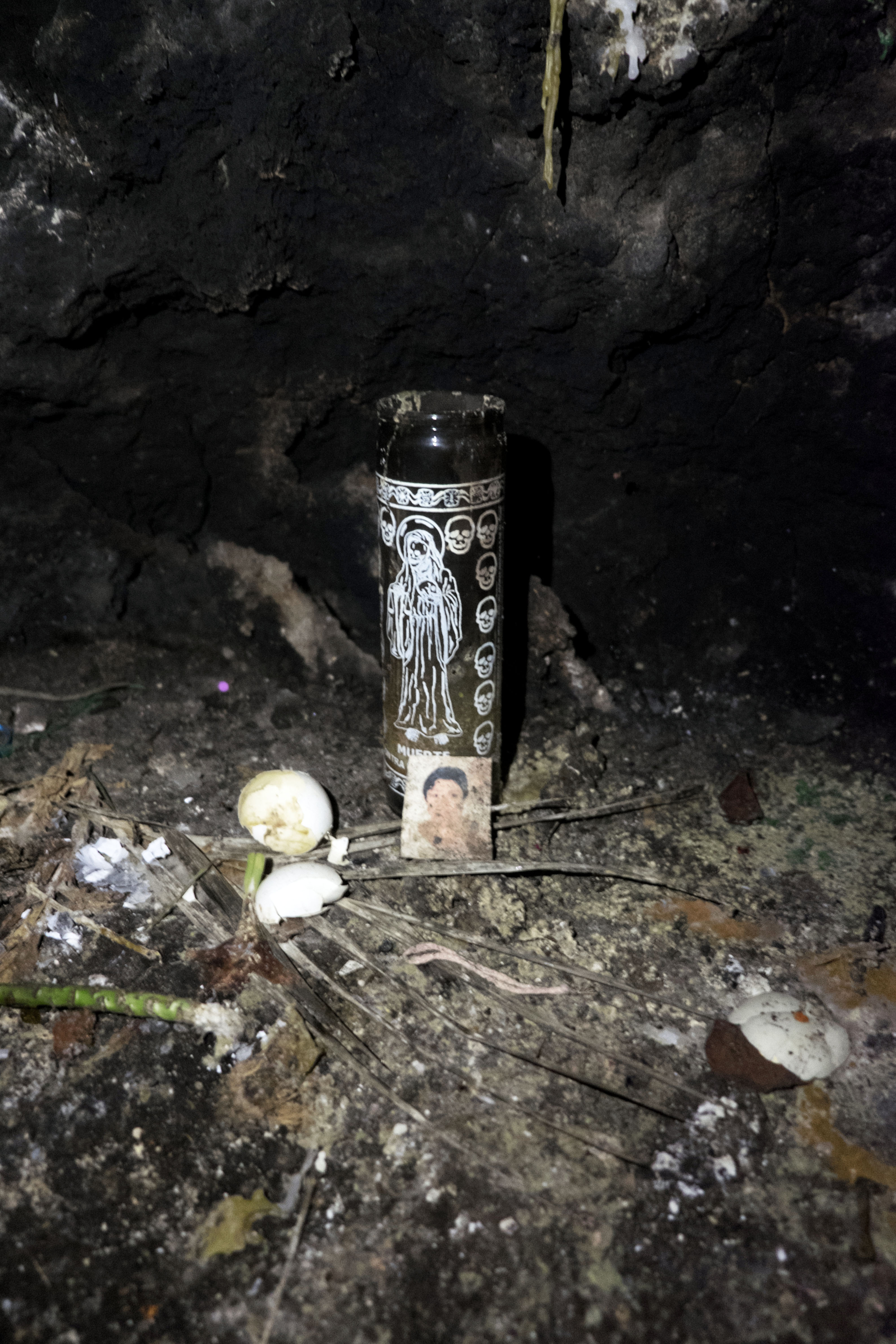Throughout the 1980s, concerned parents were led to fear that demonic influence lay hidden in much that their kids found entertaining: music, games, TV. The hysteria, dubbed the “Satanic Panic,” has passed into history, but now, in the nightmare world of Mexico’s narco wars, both the church and the state are mounting a perhaps similar campaign against Santa Muerte—the skeleton saint whom they hold responsible for the atrocities of the sicarios.
In retrospect, the Satanic Panic simply followed the time-honored tradition of parents not understand or liking what excited their children; when the same parents were young, their parents hated the Beatles. During the Reagan decade, conservative Christian belief in the reality and power of Satan, the near-universal presence of electronic media in U.S. households, and cultural spillover from the paranoid style in American politics all interbred to birth an era uniquely repelled by and obsessed with the specter of evil. Nowhere is this folkloric read of popular culture better represented than in two of the 1980s’ most salient cultural artifacts: heavy metal records and Saturday morning cartoons.
Videos by VICE
Heavy metal, of course, has enjoyed diabolical affiliation from Black Sabbath onward. But it wasn’t until the ’80s that bands like Venom and Deicide made overt hails to the Dark Lord, or that glam bands like Mötley Crüe slapped a pentagram on their album cover to generate press. The predictable responses from parents and conservative media (such as the public burning of records) guaranteed publicity. Such coverage frequently came care of the exorcist and TV host Bob Larson, who frequently hosted Satanists on his anti-occult show Talk Back.
But the most significant backlash against heavy metal during the era was against hidden, not blatant, messages. In 1985, two teenagers in Reno, Nevada, attempted suicide after listening to albums by Judas Priest. Five years later, their parents sued both the band and its record label, CBS, claiming subliminal messages like “Let’s be dead” and “Do it” had led their children to try to kill themselves. CBS and Judas Priest were both acquitted, but the case served as a grim bookend to a decade defined by such accusations.

With a reputation for aiding both sicarios and drug smugglers as well as conventional petitions for luck in love, Santa Muerte has drawn fire from both the church and society in Mexico.
While heavy metal threatened their teenagers, parents were simultaneously guarding their younger children from the occult influence in cartoons. If you want to survey the ultimate encyclopedia of satanic toy propaganda, look no further than Turmoil in The Toy Box. Originally released in 1984, the video consists of a 90-minute faux interview between the Christian author Phil Phillips and the pastor Dr. Gary L. Greenwald, in which the two ascribe occult and satanic undercurrents to an exhaustive list of children’s programming. Star Wars, for instance, borrowed the Force from witchcraft, while Scooby-Doo‘s paranormal investigations were really endorsements of the occult. The Smurfs were undead, transgendered, and gay. It was fear-mongering of the first order—but it wasn’t unprecedented.
Benjamin Radford is the author of Media Mythmakers, which analyzes narratives of ritual satanic abuse, conspiracy literature like Turmoil in The Toybox, and their attendant reception in mass media. In his analysis, the Satanic Panic compounded a normal sociological event—the conflict that exists between every generation and its youth—with the elemental fear every tribe feels toward the unknown, unseen other.
“Part of it is old wine in new bottles,” Radford said in an email to VICE. “You have these latent cultural fears about what’s going on with the world and society—’What are our kids doing? What are they into?’ With each new development, it gets repackaged.”
But add toxic media hysteria to that conflict and, he said, “you have this perfect storm of this latent conspiracy theory that there’s unseen, hidden evils trying to hurt our children. This goes back to the blood libel stories about Jews kidnapping Gentile children and us[ing] their blood for seders.”
Radford pointed out that the Ouija board, a frequent target of anti-occult propaganda, was first sold as a standard board game at the end of the 19th century; until Pearl Curran claimed to have contacted a spirit named Patience Worth via her board in 1913, it was just another number in the Hasbro catalog. He likened it to the fate of Dungeons & Dragons, the paradigmatic teenage geek pastime, which Phillips and Greenwald dragged up from the basement and into their parade of paranormal menace.
By the mid 1990s, the Satanic Panic had run its course in mainstream culture. Assertions of diabolical underpinnings are lobbed at Harry Potter or Pikachu on occasion but rarely make headlines. Still, true believers remain: When VICE asked Larson if he still saw satanic elements at work in pop culture, his response was clear.
“Are you kidding?” he said. “Everywhere. Darkness is what sells—Suicide Squad, Ouija 1 [and] 2, The Conjuring. Pick any performance of Beyoncé. On TV, [look at] True Blood, Supernatural, The Walking Dead. In none of these is a truly Judeo-Christian view of evil given serious consideration.”

The cult of Santa Muerte, which gained its first public altar in Mexico City in 2001, now claims between 8 and 10 million followers across both North and South America.
Unlike the imagined invocations of Rob Halford and He-Man, the crimes of the sicarios who follow Santa Muerte are real. This dark association stems from Santa Muerte’s status as a back-channel intercessor for less-than-holy petitions. According to Dr. Andrew Chesnut’s Devoted to Death, the great majority of Santa Muerte’s 8 to 10 million followers make peaceful requests for luck in love or business. But there’s no theological restriction on making criminal petitions and offering criminal offerings in return, up to and including human sacrifice. Both the Catholic Church and numerous Protestant communities in Mexico draw on such cases to prove that the Bony Lady has ushered in an era of unprecedented demonic activity in Mexico (which has led to a corresponding explosion of exorcisms).
Like the Satanic Panic, hysteria over Santa Muerte has its own soundtrack—but rather than relying on metal’s whiplash tempos and brutally screamed vocals, the music is heavy with accordions and tubas. Given Santa Muerte’s association with the cartels, it makes sense that the songs written in her honor would come from the narco-corrido genre, which itself grew from the folk music of Mexico’s northern states. According to Chesnut, the first such corrido to declare devotion to the Bony Lady was released in 2008: “La Santa Muerte,” with versions performed by both the singer Beto Quintanilla and the group Los Cadetes de Linares. As with the increasingly violent lyrics of other narco-corrido subgenres, the song’s lyrics are enough to make any priest cross himself.
“Yo adoro y quiero a la muerte y hasta le tengo un altar.
Ya hay millones que le rezan la iglesia empieza a temblar.
Abiertamente ya hay curas que la empiezan adorar.”
“I love and desire death and want her to have an altar.
There are already millions who pray; the church begins to tremble.
There are already priests who openly begin to worship her.”
Santa Muerte received her own version of Turmoil in The Toy Box in 2007, when the evangelical Christian director Paco del Toro released La Santa Muerte. The plot depicts how a woman’s innocent appeal to the Bony Lady for help in her love life leads to the possession of a human soul. Like the filmography of the Satanic Panic, the production values are low. But like The Exorcist, it’s tapped into a nation’s fear of uncontrollable evil—even if the worst devils may be flesh and blood.
VICE creative services, in partnership with the new FOX series THE EXORCIST, presents a series around real-life exorcisms. Don’t miss THE EXORCIST starting Fridays Sept 23 on FOX. This article was created independently from VICE’s editorial team.
More
From VICE
-

Erickson Memorial Chapel (Credit: Google Maps) -

Skynesher/Getty Images -

VICTOR HABBICK VISIONS/GETTY IMAGES -

Gavin Rossdale in the kitchen (Credit: Courtesy of Gavin Rossdale)